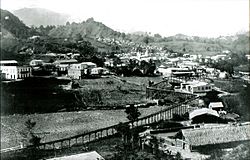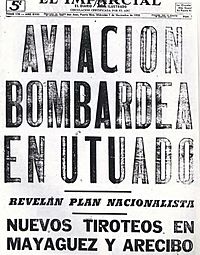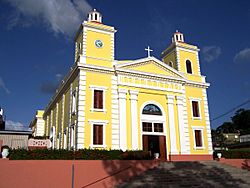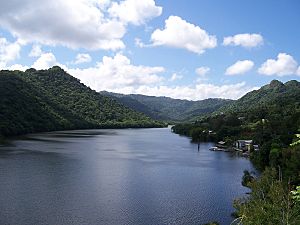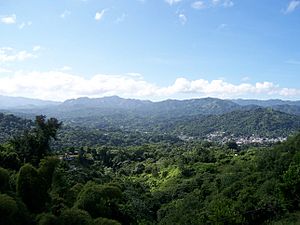Utuado, Puerto Rico facts for kids
Quick facts for kids
Utuado
Municipio de Utuado
Otoao
|
|||
|---|---|---|---|
|
Town and Municipality
|
|||
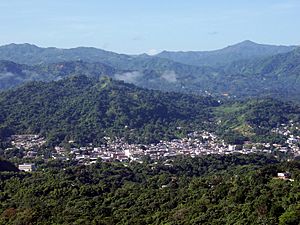
View of Utuado Pueblo from Sabana Grande barrio
|
|||
|
|||
| Nicknames:
Ciudad del Viví, Los Montañeses, Cuna de Campeones
|
|||
| Anthem: "Valle Bendito el de Mi Otoao" | |||

Map of Puerto Rico highlighting Utuado Municipality
|
|||
| Commonwealth | |||
| Founded | October 12, 1739 | ||
| Barrios | |||
| Area | |||
| • Total | 114.99 sq mi (297.83 km2) | ||
| • Land | 113.45 sq mi (293.83 km2) | ||
| Population
(2020)
|
|||
| • Total | 28,287 | ||
| • Density | 245.989/sq mi (94.977/km2) | ||
| Demonym(s) | Utuadeños | ||
| Time zone | UTC−4 (AST) | ||
| ZIP Codes |
00641, 00611
|
||
| Area code(s) | 787/939 | ||
| Major routes | |||
Utuado is a town and municipality of Puerto Rico located in the central mountainous region of the island known as La Cordillera Central. It is located north of Adjuntas and Ponce; south of Hatillo and Arecibo; east of Lares; and west of Ciales and Jayuya. In land area it is the third-largest municipality in Puerto Rico (after Arecibo and Ponce). According to the 2020 US Census, the city has a population of 28,287 spread over 24 barrios and Utuado pueblo (the downtown area and the administrative center of the city). The name Utuado derives from the Taíno word otoao, meaning between mountains (i.e. valley). The municipality is known as Ciudad del Viví (Viví City), derived from the Viví River which runs through Utuado: one river branch comes from Adjuntas and the other from Jayuya. These two rivers then meet near the Fernando L. Ribas Dominicci Avenue and continue the journey to Lago Dos Bocas.
Utuado is the main municipality of the Utuado micropolitan statistical area and is part of the San Juan-Caguas-Fajardo Combined Statistical Area.
Contents
History
Utuado was founded October 12, 1739, by Sebastian de Morfi, on behalf of 60 families from Arecibo. It was the first town established in the interior mountainous region of the island known as La Cordillera Central and the 11th oldest established municipality in Puerto Rico, following San Juan, San Germán, Coamo, Arecibo, Aguada, Loiza, Ponce, Añasco, Guayama and Manatí.
Columbus's arrival
At the time of the discovery of the island on November 19, 1493, by Christopher Columbus, Puerto Rico was inhabited by the Taíno Indians. The Taínos were a culturally developed society with a universal language, a developed agricultural system, and a social organization based on caciques or chieftains. The Utuado area was ruled over by cacique Guarionex. In barrio Caguana, the Taínos built a series of courts or bateyes, Caguana Ceremonial Ball Courts Site, that is considered the best example of Taino engineering in the West Indies.
Early history: XVI–XVIII
In his work El Dorado Borincano, La economia de la conquista 1510–1550, Jalil Sued Badillo gives a detailed account of the economic state of Puerto Rico during the first decades after the discovery and mentions the importance of the Otoao region. From 1510 through 1513, the island witnessed a Taíno rebellion as a result of harsh and inhumane treatment by the Spanish settlers. During the process of pacification many Spaniards settled in the area now occupied by the municipality of Utuado and set up farms (haciendas), initially on behalf of the Spanish government (Hacienda Real Dos), to provide food to the Indian slaves working the gold mines and the Spanish colonists in the area. One of the first settlers in the Otoao region in 1512 was Antonio Sedeño, the island's bookkeeper. His farm's main crop was yuca. His farm was sold in 1519 to Blas de Villasante, the island's treasurer, for 525 gold pesos.
Areas in the Utuado region that were exploited for gold include Salto Arriba, initially, then later in the 1530s Caguana and Don Alonso. In the 1530s, landowners in the Don Alonso area petitioned the Spanish Crown permission to establish a town in the area but it was never granted.
Once the gold mining era ends toward the end of the 16th century, very little is known about the Utuado region until the early 18th century. According to the Puerto Rican historian Fernando Picó, the few documents that exist indicate the area was mostly unpopulated and densely forested. On the other hand, he states that Utuado is the municipality with the most caves, that most likely served as dwellings for Indians or runaway slaves.
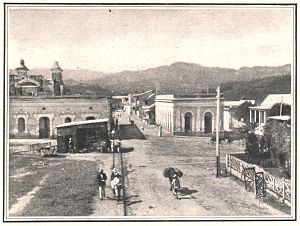
The agreement to establish the town of Utuado by the 60 families of Arecibo states they purchased the "Hato de Otoao" for 569 pesos and 5 reales from owners Manuel Natal and Felipa Román. It also states their desire to choose where on the land the town center would be located, which indicates the area was not populated yet.
During his visit to the island in 1771, Fray Iñigo Abbad y Lasierra states the principal economic activity in the Utuado region was cattle raising, horses and mules. He mentions a small amount of agricultural activity existed but the population only produced enough tobacco and coffee for their own consumption.
During the late 18th and early 19th centuries, Utuado's population continued to grow as coffee gained in importance and growers saw the need for high altitudes and mountainous terrain to produce the best coffee beans. People not only migrated from the Puerto Rican coastal towns but also from Ireland (Founder Sebastian de Morfi = Sebastian Murphy), Canary Islands and the Balearic Islands of Majorca and Minorca, all seeking the riches that coffee had to offer.
Golden era of coffee – "black gold"
During the late 19th century Utuado experienced an explosive economic growth centered around the cultivation of coffee, also known at the time as oro negro or "black gold". By the 1890s Utuado was the largest producer of coffee in Puerto Rico and the second municipality (after Ponce) with the largest population. It produced a rich social life for many of its citizens and a casino and theatre were established in the town. The progress of the town was so evident that the regent Queen of Spain, María Cristina, honored the town with the title of Ciudad (City) on August 20, 1894. In 1896 or 1897 Utuado was the first city in Puerto Rico with a public electric lighting system powered by a hydraulic turbine power plant, and in that same year mayor Juan Casellas planned a train system to unite Utuado with Arecibo. By 1899 this golden era ended due to two events: the United States occupation of the island in 1898, which made sugar the new crop of importance instead of coffee (Utuado's mountainous landscape was not ideal for growing sugarcane, making it impossible for it to compete in the sugar industry), and Hurricane San Ciriaco in 1899, which destroyed the coffee haciendas.
Massacre
One of the most tragic moments in Utuado's history occurred on October 30, 1950, during the Utuado Uprising against United States rule, which culminated in what is known as the "Utuado Massacre". In Utuado a group of 32 nationalists, led by nationalist leaders Heriberto Castro and Damián Torres, fought against the local police during the independence revolts which occurred in various cities and towns of the island. The group was reduced to 12 men and retreated to the house of Damián Torres. Torres' residence was attacked by 50-caliber machine-gun fire from ten American P-47 Thunderbolt planes. The National Guard arrived later that day and ordered the nine men who survived the attack to surrender. Once the nationalists surrendered they were forced to march down Dr. Cueto Street to the local town plaza where their shoes, belts and personal belongings were removed. The group was then taken behind the police station where they were machine gunned. Four of the nationalists died in the act, they were nationalist leader Heriberto Castro, Julio Colón Feliciano, Agustín Quiñones Mercado, Antonio Ramos and Antonio González. González, who was 17 years old, pleaded for water and instead was bayoneted to death.
Geography
- Rio Abajo State Forest - between Arecibo and Utuado
Wards
- Ángeles
- Arenas
- Caguana
- Pueblo
- Caonillas Abajo
- Caonillas Arriba
- Consejo
- Don Alonso
- Guaonico
- Las Palmas
- Limón
- Mameyes
- Paso Palma
- Santa Rosa
- Roncador
- Sabana Grande
- Salto Abajo
- Salto Arriba
- Santa Isabel
- Tetuán 1
- Tetuán 2
- Viví Abajo
- Viví Arriba
Tourism
Landmarks and places of interest
- El Saltillo waterfall
- Dos Bocas Lake
- Caonillas Lake
- Hacienda Roses
- Monuments to the Utuado Soldiers
- Caguana Ceremonial Ball Courts Site
- Rio Abajo State Forest
With narrow streets leading up to a central plaza surrounded by a church and the governor's house, Utuado Pueblo is an example of a town built during the Spanish Colonial era of Puerto Rico. The Iglesia San Miguel Arcangel, the local Catholic parish, was founded in 1746. The current double-steepled church was built between 1872 and 1878 and is listed in the National Register of Historic Places, along with the Caguana Ceremonial Park and the Blanco Bridge or "Puente Blanco" located in barrio Arenas joining Utuado with Adjuntas. Other buildings in Utuado Pueblo that retain their colonial architectural features include The Center for Art, Culture and Tourism in the old Tobacco Coop building, the old hospital "Hospital Catalina Figueras and Teatro San Miguel, among others.
The Rio Abajo State Forest (Bosque Estatal Rio Abajo) is a 5,780-acre (23 km2) forest reserve shared with Arecibo and home to 223 plants and wildlife species including: native ceiba (Ceiba pentandra), Asian teaks (Tectona spp.), West Indian mahogany (Swietenia mahagoni), Honduran mahogany (S. humilis) and Australian pines (Casuarina spp.). It is also home to the federally endangered Puerto Rican broad-winged hawk (Buteo platypterus brunnescens) as well as a captive population of the critically endangered Puerto Rican parrot (Amazona vittata). Captive parrots are slowly being released into Rio Abajo in an attempt to form a second population of parrots on the island.
East of the Rio Abajo Forest Reserve is the Dos Bocas Lake and dam, one of several man-made lakes in Utuado. From El Embarcadero, near routes 123 and 146, boats take guests around the water to one of the many restaurants for lakeside dining.
The Caonillas Lake and dam in the western region of Utuado is another man-made lake. This reservoir encompasses over 50 square miles (130 km2) and was constructed in 1948 by the Puerto Rico Electric Power Authority.
Culture
Sports
- Baseball
The Montañeses de Utuado ([Utuado Mountaineers] Error: {{Lang-xx}}: text has italic markup (help)) are a AA-league baseball team based in Utuado that competes in the Puerto Rico Amateur Baseball Federation. The team achieved its first national championship in 1941 under the then Federación Deportiva del Norte ([Sports Federation of the North] Error: {{Lang-xx}}: text has italic markup (help)). Their second national championship was in 1970 under the current Federación de Béisbol Aficionado de Puerto Rico. The team won their third national championship on September 1, 2007 against the Bravos de Cidra ([Cidra Braves] Error: {{Lang-xx}}: text has italic markup (help)). On September 14, 2014, the Montañeses won their fourth national championship title against the Brujos de Guayama ([Guayama Warlocks] Error: {{Lang-xx}}: text has italic markup (help)) winning the fourth and final game in a stunning 7-game final.
- Table Tennis
Utuado's table tennis players include sisters Adriana, Melanie, Gabriela and Fabiola Diaz, Bryan Afanador, Daniel González, Richard Pietri, Daniely Ríos and Yomar González, all members of the Águilas de la Montaña Table Tennis Club. Both Brian Afanador and Adriana Diaz, members of the International Table Tennis Federation World HOPES Team, have risen to prominence all over the Caribbean, Latin America and the world in their respective categories. The head coaches of the table tennis athletes are Bladimir Diaz and Eladio Afanador, the latter a high level performance program coach.
- Mayagüez 2010 athletes
Six athletes of Utuado competed in Mayagüez 2010: Antonio "Tonito" Acevedo (baseball), Diamilette Quiles (softball), Giovanni González (table tennis), Luis Collazo (marathon) and sisters Paola and Fabiola Álvarez (both pneumatic shooting).
Festivals and events
- National BBQ Festival - Originated by locals Samuel Kanig and Ramon G. Garcia, it is a one-day barbecue festival held on the fist Sunday of January. It is an annual family event where people exhibit their own creativity by building unique barbecues made from common and uncommon household items. The festival has exhibited barbecue grills made from items such as a toolbox, coffin, light post and even an automobile.
- Juan Domingo Reyes Negrón Bike Day of Friendship - An annual bike day celebrated since 2001, between February and March. Celebrated in memory of Juan Domingo Reyes Negrón, a boy who died in a truck impact while in his bicycle in 2000, the idea was originated by the First Lady, Ivelisse Reyes, and has been sponsored by the Municipal Government of Utuado and the Municipal Office of Recreation and Sports.
- Barrio Angeles Fiesta - April
- Tierra Adentro Festival - Hosted annually by the Agricultural Technology department of the University of Puerto Rico at Utuado, featuring arts and crafts by local artisans, cultural music, food and plant and animal exhibitions. This festival is held in April from a Wednesday to Sunday.
- Guarionex Fiestas - April
- Angeles Artisanal Fair - An annual arts & crafts fair held in early May in barrio Angeles featuring local artisans, music and food.
- Rosary Cross - May
- Longaniza Festival - Celebrated its first year on June 2009, it was the lifelong dream of Don Jose A. Carmona "Don Toño" to establish it to celebrate his legacy with his children (his own recipe for seasoning the sausage) and bring another special celebration to the mountain town and celebrate the longaniza.
- Fiestas Patronales - Held towards the end of September to early October in honor of the town's patron saint, San Miguel Arcangel. They were held outside the town's central plaza while undergoing remodeling and after, to prevent major damage and returned to the plaza in 2013.
- Otoao Cultural Festical - An annual cultural event held in the beginning of December celebrating Utuado's Taino heritage. It features arts & crafts, concerts, food and dance and takes place in the central plaza "'Plaza del Recreo'" in Utuado Pueblo.
Transportation
With the recent completion of Highway 10, Utuado has become one of the easiest towns in the interior mountainous region to reach from the San Juan metropolitan area. What used to be a 3-hour trip has been reduced to 1 hour and 30 minutes (to reach the central town). There are 64 bridges in Utuado. Many of Utuados roads and bridges were destroyed by Hurricane Maria in 2017. Utuado sustained approximately $36 million in damages to its roads and bridges as a result of the hurricane. Funding to reconstruct a bridge in Arenas barrio, destroyed by Hurricane Maria in 2017, was made available in February 2021 and work was set to begin in June.
Economy
Agriculture
Utuado has regained some of its coffee producing power and was the 3rd largest coffee producer in Puerto Rico in the 2002 USDA Agricultural Census. It also produces oranges (ranked 4th), plantains (ranked 6th) and bananas (ranked 9th). It has been successful with livestock inventory ranking 3rd with hives of bees and 13th with pigs. In terms of manufacturing, Utuado has facilities producing textiles, paper and stone.
Business
Utuado today is equipped with a modern and competitive telecommunications infrastructure. Major cell phone companies including Claro and AT&T offer mobile coverage. Liberty Cablevision and DirecTV offer cable and satellite television service, with Spanish and English channels as well as high-speed Internet service.
Demographics
| Historical population | |||
|---|---|---|---|
| Census | Pop. | %± | |
| 1900 | 43,860 | — | |
| 1910 | 41,054 | −6.4% | |
| 1920 | 35,135 | −14.4% | |
| 1930 | 37,434 | 6.5% | |
| 1940 | 42,531 | 13.6% | |
| 1950 | 46,625 | 9.6% | |
| 1960 | 40,449 | −13.2% | |
| 1970 | 35,494 | −12.2% | |
| 1980 | 34,505 | −2.8% | |
| 1990 | 34,980 | 1.4% | |
| 2000 | 35,336 | 1.0% | |
| 2010 | 33,149 | −6.2% | |
| 2020 | 28,287 | −14.7% | |
| U.S. Decennial Census 1899 (shown as 1900) 1910–1930 1930–1950 1960–2000 2010 2020 |
|||
Education
There are currently 20 schools under the Puerto Rico Department of Education system, 2 private schools and one college level institution; the vast majority of children in Utuado attend public schools. The main primary-level education institutions include María Libertad Gómez, Bernardo González, and Judith A. Vivas, among others located outside Utuado Pueblo. Among the principal secondary-level institutions are the Francisco Ramos Middle School, Luis Muñoz Rivera High School and Antonio Reyes Padilla Vocational High School. While most students attend the before-mentioned schools, Utuado also has two private education institutions, both primary-level: Colegio Utuadeño San José and Academia Dailén. Founded in 1979, the University of Puerto Rico at Utuado is the youngest campus of the University of Puerto Rico and the only post secondary-level institution in Utuado, specializing in agricultural studies in areas such as pest control, horticulture, livestock industry and agricultural production.
Notable people
- Brian Afanador, table tennis athlete and Olympian, cousin to sisters Adriana and Melanie Díaz
- Roberto Cortés, Telemundo Puerto Rico weather anchor
- Adriana and Melanie Díaz, table tennis athletes and Olympians, cousins to Brian Afanador
- PFC Fernando Luis García, US Marine private, killed in action in 1952 during the Korean War
- María Libertad Gómez Garriga, educator and politician
- Major Fernando L. Ribas Dominicci, US Air Force pilot, killed in action during Operation El Dorado Canyon
- Marisol Malaret, Miss Puerto Rico 1970 and Miss Universe 1970
- Nuria Sebazco, Telemundo Puerto Rico news reporter
- Ramona Trinidad Iglesias (1889–2004), world's oldest person and the last person born in 1889, she was 114 years and 272 days old
- Normando Valentín, WAPA-TV news reporter, anchor and journalist
- Melvin "Memo" Rodriguez (Baseball player- Doble AA)
- Celimar Adames ( Journalist Teleonce)
- Katiria Soto ( Journalist WAPA)
- Kefren Velazquez ( Journalist)
Images for kids
See also
 In Spanish: Utuado para niños
In Spanish: Utuado para niños




